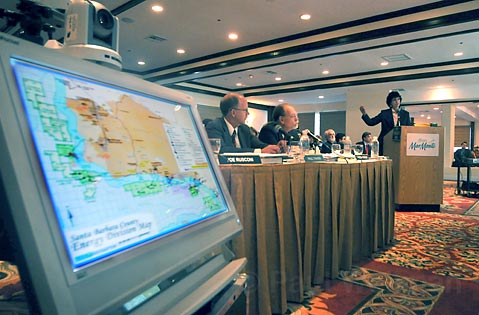PXP and EDC: A Grand Plan
Environmental leaders explain how they came to agreement with Plains Exploration and Production.

When Plains Exploration and Production (PXP) representatives approached the Environmental Defense Center (EDC) in February 2007, requesting a meeting with environmental groups about the company’s Tranquillon Ridge offshore oil drilling project, we were skeptical. EDC had been representing Get Oil Out! (GOO!) and the Citizens Planning Association (CPA) in opposition to the Tranquillon Ridge Project since 1997. We had successfully defeated a prior application in 2002. But, since we have a policy to honor such requests, we agreed to meet with PXP.
It became clear during our first meeting that PXP representatives had thoroughly done their homework by reading our comment letters, and that they took our concerns seriously. PXP began the discussion by offering to address our main concern: that its proposal would extend the life of existing oil drilling operations at Platform Irene. The company agreed to shut down all new and existing drilling, on a set date, when current operations from the platform were predicted to end.
We already knew that the proposal would use an existing platform, pipelines, and processing facility, and that no new facilities would be required. We also knew that PXP was already pumping oil out of the Tranquillon Ridge Field from federal waters, an approach that would simply take much longer to complete.
Under current law, oil companies have the right to drill without any end dates. Twenty-seven platforms currently exist offshore California (20 in the Santa Barbara Channel), many of them operating well beyond their original life expectancies. New slant-drilling technology could allow many of these platforms to continue in operation, continuing their threats to the Channel, for several decades. For example, Platform Holly was placed in state waters in 1966 and is still there 44 years later with no end in sight, and proposals are pending to expand its drilling operations.

That being said, we were not interested in talking with PXP until the company threw in a proposal to shut down three additional platforms operating offshore of Point Conception. These three platforms – the Pt. Arguello platforms – represent the biggest threat of new leasing offshore California because they can be used to slant-drill into surrounding areas. When PXP offered to shut down the Pt. Arguello platforms, as well as Platform Irene, we came to the table. We insisted that PXP not only shut down all four of its platforms (three in 9 years and one in 14 years), but that it must also remove its two onshore processing plants so that they could not be used for oil development in our area in the future. We even demanded that PXP turn over the underlying lands to a public trust. In response to our demands, PXP agreed to turn over 3,700 acres adjacent to the Burton Mesa Ecological Reserve and up to 200 acres on the Gaviota Coast. These lands will be protected as public open space in perpetuity.
After securing PXP’s agreement to shut down existing oil production – which otherwise can continue indefinitely – and placing guarantees on that agreement by requiring the removal of the onshore facilities and putting the lands in public trust (through an agreement with The Trust for Public Land), we required PXP to make their project carbon neutral.
At every demand, we fully expected PXP’s representatives to walk away, but they didn’t, and we finally reached a settlement agreement we all could support.
Without this plan, we will continue in exactly the situation we are in today, with no potential end to existing oil drilling. We will continue to face a threat of new leasing, now that the federal moratorium on offshore drilling has ended, and the likelihood that existing platforms will be used to drill into new lease tracts.
EDC, GOO! and CPA are working to bring this plan back before the California State Lands Commission and, if it is approved there, the California Coastal Commission. We have addressed concerns raised by the SLC a year ago and will soon be signing and releasing a new agreement with PXP, reflecting those changes, which are as follows:
1) This agreement will be made public.
2) The State of California will be made a third party beneficiary, allowing the Attorney General to enforce the terms of the agreement.
3) PXP has not only agreed to cease production, but to also surrender its federal leases in accordance with the end dates.
4) The Trust for Public Land has provided written confirmation that there are no title or physical condition issues that would interfere with conveyance of the lands for permanent public use and conservation.
5) Since the execution of the original agreement, the State of California has developed protocols for dealing with GHG emission reporting and offsets, which will be incorporated into the project.
This agreement and the new measures added to it will ensure that approval of the Tranquillon Ridge plan will lead to the end of oil development off the Santa Barbara County coast. Alternative energy sources will receive the boost they need to succeed, and to replace our dependence on carbon based fuels, as these platforms are shut down and the onshore oil processing facilities dismantled.
The time to move this plan back to the State Lands Commission for a second review is now. With the federal moratorium lifted, oil companies are chomping at the bit to use existing facilities to obtain the right to lease in federal waters. What better way to say “No” than to make this plan—supported by Congresswoman Lois Capps, our County Supervisors, and virtually every environmental organization in the region—a reality?



